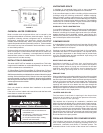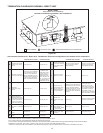
7
GROUNDING INSTRUCTIONS
This boiler must be grounded in accordance with the National
Electrical Code and/or local codes. Boiler is polarity sensitive;
correct wiring is imperative for proper operation.
This boiler must be connected to a grounded metal, permanent
wiring system, or an equipment grounding conductor must be
run with the circuit conductors and connected to the equipment
grounding terminal or lead on the boiler.
INLET WATER CONSIDERATIONS
To minimize the amount of condensate, a minimum inlet
water temperature to the heat exchanger of 120°F (49°C)
shall be maintained. This temperature can be acquired by
returning120°F(49°C)waterfromtheremotestoragetankto
the boiler or by installing a by-pass loop between the boil er’s
inlet and outlet connec tions. When installing a by-pass loop, a
remote probe MUST be used, see SYSTEM INSTALLATION.
Circulating water through the boiler and to the remote storage
tank(ifapplicable)isaccomplishedbyapumponVWmodels
only. For hot water heating systems using the VB model,
the circulating pump is NOT provided on standard models
(optional)andmustbefieldinstalled.
CORRECT GAS
MAKE SURE THE GAS ON WHICH THE BOILER WILL
OPERATE IS THE SAME AS THAT SPECI FIED ON THE
BOILER RATING PLATE. DO NOT INSTALL THE BOILER
IF EQUIPPED FOR A DIFFERENT TYPE OF GAS — CON-
SULT YOUR SUPPLIER.
PRECAUTIONS
IF THE UNIT IS EXPOSED TO THE FOLLOWING, DO
NOT OPERATE UNTIL ALL CORRECTIVE STEPS HAVE
BEEN MADE BY A QUALIFIED SERVICE AGENT:
1. EXPOSURE TO FIRE.
2. IF DAMAGED.
3. FIRING WITHOUT WATER.
4. SOOTING.
IF THE BOILER HAS BEEN EXPOSED TO FLOODING,
IT MUST BE REPLACED.
LIQUEFIED PETROLEUM GAS MODELS
Boilersforpropaneorliquefiedpetroleumgas(LPG)are
different from natural gas models. A natural gas boiler will not
function safely on LP gas and no attempt should be made to
convert a boiler from natural gas to LP gas.
LP gas must be used with great caution. It is highly
explosive and heavier than air. It collects first in the low
areas making its odor difficult to detect at nose level.
If LP gas is present or even suspected, do not attempt
to find the cause yourself. Leave the building, leaving
doors open to ventilate, then call your gas supplier or
service agent. Keep area clear until a service call has
been made.
At times you may not be able to smell an LP gas leak.
One cause is odor fade, which is a loss of the chemical
odorant that gives LP gas its distinctive smell. Another
cause can be your physical condition, such as having
a cold or diminishing sense of smell with age. For
these reasons, the use of a propane gas detector is
recommended.
IF YOU EXPERIENCE AN OUT OF GAS SITUATION, DO
NOT TRY TO RELIGHT APPLIANCES YOURSELF. Call
your local service agent. Only trained LP professionals
should conduct the required safety checks in accordance
with industry standards.
HIGH ALTITUDE INSTALLATIONS
Rated inputs are suitable up to 7000 feet (2134m)
elevation. Consult the factory for installation at altitudes
over7000feet(2134m).
FIELD INSTALLED COMPONENTS
When installing the boiler, the follow ing compo nents
MUST be installed:
1)CirculatingPump(Hydronic)
2)TankTemperatureControlProbe(HotWaterSupply)
3)RemoteTemperatureControlProbe(Hydronic)
4)StorageTankT&PReliefValve
5)ManualGasShutoffValve(Supply)
Check the FEATURES AND CONTROLS section for further
information.


















